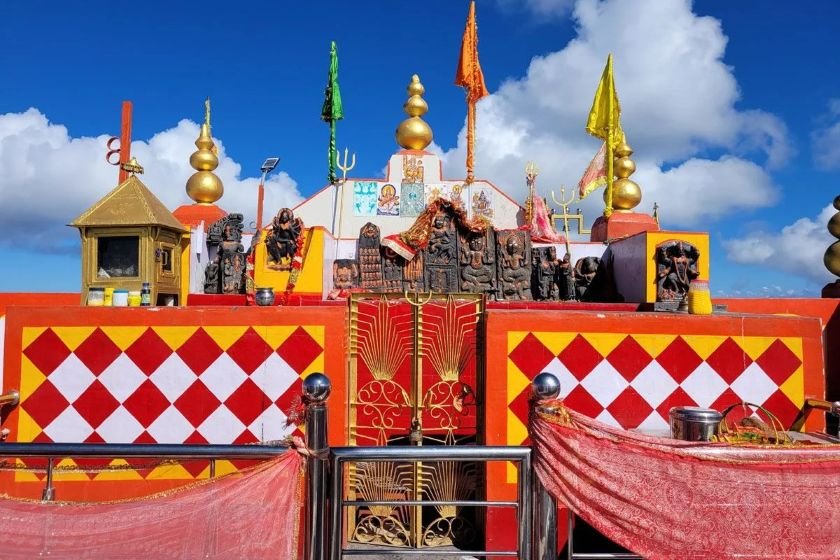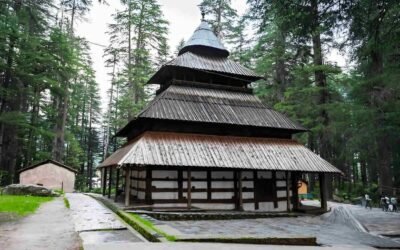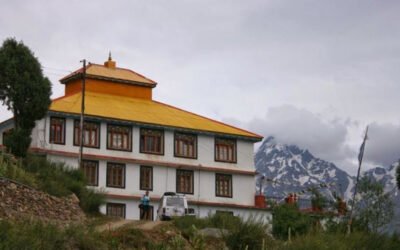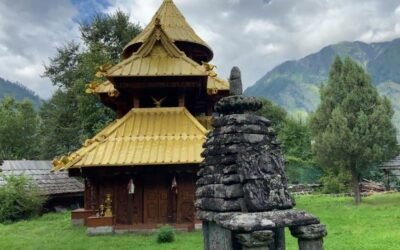Where the sky is her canopy, and the winds carry the whispers of the Pandavas
Perched at a staggering 3,359 meters (11,020 feet) above sea level, the Shikari Devi Temple crowns the highest peak in Mandi district, overlooking the Seraj and Karsog valleys. This ancient shrine, dedicated to Shikari Devi, the Goddess of the Hunt, is a place of mystery, myth, and unmatched Himalayan majesty. With no roof above her sanctum, the goddess sits beneath the open sky—untouched by snow, yet surrounded by it.
🌄 Location & Accessibility
- Location: Shikari Hill, near Janjehli, Seraj Valley, Mandi District, Himachal Pradesh – 175047
- Altitude: 3,359 meters
- By Road: 18 km from Janjehli, 94 km from Mandi; accessible by 4×4 vehicles or on foot
- By Rail: Joginder Nagar or Shimla Railway Station (~100–120 km)
- By Air: Bhuntar Airport (~120 km) or Chandigarh Airport (~200 km)
- Trek Routes:
- From Janjehli (18 km) – scenic and popular
- From Karsog (via Kamru Nag) – longer and adventurous
🕉️ Deity & Worship
The temple is dedicated to Shikari Devi, a fierce form of Durga, worshipped as the protector of forests, wildlife, and hunters. According to legend:
- The Pandavas built this temple during their exile, after encountering a mystical deer that vanished into the forest
- Realizing it was a divine form, they prayed, and the goddess appeared, asking to be enshrined atop the peak
- She is worshipped in the form of a pindi, under the open sky, as no roof has ever stayed intact—a mystery that continues to baffle devotees and architects alike
Devotees offer red flags, coconuts, and ghee lamps, and the temple is especially visited during Navratri, when thousands trek to the summit to seek her blessings.
🏛️ Architecture & Setting
The temple is a roofless stone sanctum, surrounded by:
- Stone walls and prayer flags, fluttering in the high-altitude wind
- A massive courtyard used for rituals and community gatherings
- Panoramic views of the Pir Panjal, Dhauladhar, and Great Himalayan ranges
- A sacred pond and forested trails, alive with birdsong and alpine flora
Despite heavy snowfall in winter, snow never settles on the goddess’s idol, adding to the temple’s mystique.
📜 Mythological Significance
- Pandava Connection: The temple is believed to have been built by the Pandavas, and the surrounding forests are dotted with Pandava caves and relics
- Navdurga Manifestation: The goddess is considered a form of Navdurga, and her blessings are sought for protection, fertility, and justice
- Roofless Mystery: Every attempt to build a roof has failed—winds tear it down, and locals believe the goddess prefers the sky as her canopy
🎉 Festivals & Celebrations
- Navratri (Spring & Autumn): Marked by devta processions, folk dances, and night-long bhajans
- Annual Shikari Fair: A local celebration with animal offerings, community feasts, and traditional music
- Daily Worship: Morning and evening aartis, incense offerings, and chanting of Durga Saptashati
🏞️ Nearby Attractions
- Janjehli Valley: A pristine Himalayan hamlet with trekking trails and wooden homes
- Kamru Nag Temple: A lake-top shrine with its own Mahabharata legends
- Karsog Valley: Known for ancient temples and apple orchards
- Budha Kedar & Pandav Sheela: Sites linked to the Pandavas’ exile
🙏 Spiritual Experience
The Shikari Devi Temple is not just a shrine—it is a skyward altar, a place where the goddess sits beneath the stars, and devotion rises with the mist. As you stand before her sanctum, with the wind howling like a mantra and the snow swirling around but never touching her, you feel the presence of a deity who defies walls and welcomes the world. It is a temple where faith breathes in the open, and the **soul finds its wild, fearless voice.




